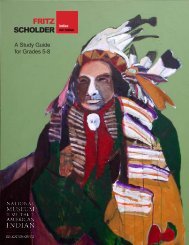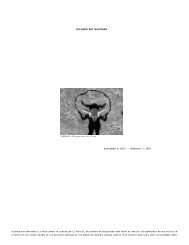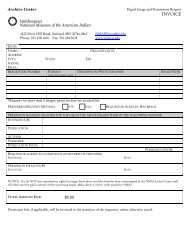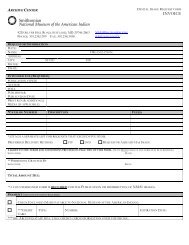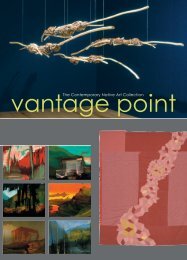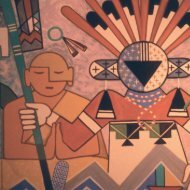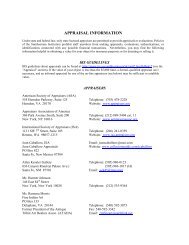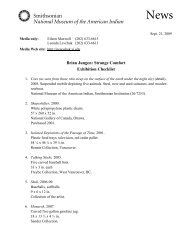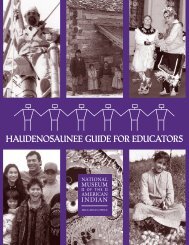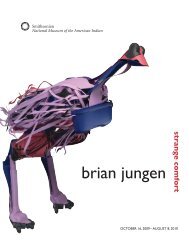Lone Dog's Winter Count - National Museum of the American Indian ...
Lone Dog's Winter Count - National Museum of the American Indian ...
Lone Dog's Winter Count - National Museum of the American Indian ...
Create successful ePaper yourself
Turn your PDF publications into a flip-book with our unique Google optimized e-Paper software.
GLOSSARY FOR<br />
TEACHERS<br />
Oral tradition—in a society without a<br />
written language, <strong>the</strong> way in which all<br />
history and culture is remembered by<br />
individuals and passed down orally from<br />
generation to generation.<br />
<strong>Winter</strong> <strong>Count</strong>—a series <strong>of</strong> pictographs<br />
drawn on buffalo hide, cloth, or paper<br />
that was used to help remember<br />
community history among some tribes<br />
<strong>of</strong> <strong>the</strong> Nor<strong>the</strong>rn Great Plains.<br />
Pictograph—a figure drawn on a winter<br />
count to serve as a symbol <strong>of</strong> one significant<br />
event chosen by <strong>the</strong> community to<br />
commemorate each year.<br />
Keeper—<strong>the</strong> person with <strong>the</strong> responsibility<br />
<strong>of</strong> maintaining a winter count and<br />
remembering and passing on <strong>the</strong> history<br />
associated with it.<br />
Mnemonic device—an object, such as a<br />
winter count, that serves as a memory aid<br />
and a tool to help keep track <strong>of</strong> history.<br />
Nakota—one <strong>of</strong> three dialects (slightly<br />
different versions) <strong>of</strong> <strong>the</strong> Sioux language.<br />
Also used as a term to identify <strong>the</strong> groups<br />
<strong>of</strong> <strong>American</strong> <strong>Indian</strong>s who speak <strong>the</strong> dialect.<br />
Dakota—one <strong>of</strong> three dialects (slightly<br />
different versions) <strong>of</strong> <strong>the</strong> Sioux language.<br />
Lakota—one <strong>of</strong> three dialects (slightly<br />
different versions) <strong>of</strong> <strong>the</strong> Sioux language<br />
Yanktonais—one <strong>of</strong> three sub-groups <strong>of</strong><br />
Nakota speakers. <strong>Lone</strong> Dog, <strong>the</strong> last<br />
known keeper <strong>of</strong> <strong>the</strong> <strong>Lone</strong> Dog <strong>Winter</strong><br />
<strong>Count</strong>, was a Yanktonais.<br />
Tiyospaye—among Sioux tribes, an<br />
extended family group that lived and<br />
traveled toge<strong>the</strong>r; usually numbering<br />
about 150-300 people.<br />
TEACHER<br />
RESOURCES<br />
Books and Articles for Adults<br />
Burke, Christina E. “Collecting Lakota<br />
Histories: <strong>Winter</strong> <strong>Count</strong> Pictographs and<br />
Texts in <strong>the</strong> <strong>National</strong> Anthropological<br />
Archives.” <strong>American</strong> <strong>Indian</strong> Art 26:1<br />
(2000): 82-89, 102-03.<br />
DeMallie, Raymond J., ed. Handbook<br />
<strong>of</strong> North <strong>American</strong> <strong>Indian</strong>s, Vol. 13<br />
Plains. Washington, DC: Smithsonian<br />
Institution, 2001.<br />
(See esp. articles on <strong>the</strong> Sioux and on<br />
Tribal Traditions and Records)<br />
Greene, Candace S. and Russell Thornton,<br />
eds. The Year <strong>the</strong> Stars Fell: Lakota <strong>Winter</strong><br />
<strong>Count</strong>s at <strong>the</strong> Smithsonian. Lincoln,<br />
Nebraska: University <strong>of</strong> Nebraska Press,<br />
forthcoming.<br />
Books for Children<br />
Bruchac, Joseph. A Boy Called Slow:<br />
The True Story <strong>of</strong> Sitting Bull. New York:<br />
Putnam, 1998. (primary)<br />
Penman, Sarah, ed. Honor <strong>the</strong><br />
Grandmo<strong>the</strong>rs: Dakota and Lakota<br />
Women Tell Their Stories. St. Paul:<br />
Minnesota Historical Society Press,<br />
2000. (middle school)<br />
Sandoz, Mari. The Story Catcher. Lincoln,<br />
Nebraska: University <strong>of</strong> Nebraska Press,<br />
1986. (secondary)<br />
Standing Bear, Lu<strong>the</strong>r. My People, <strong>the</strong><br />
Sioux. Lincoln, Nebraska: University <strong>of</strong><br />
Nebraska Press, 1975. (secondary)<br />
Todd, Anne M. The Sioux: People <strong>of</strong> <strong>the</strong><br />
Great Plains. Mankato, Michigan:<br />
Bridgestone Books, 2003. (middle school)<br />
Wood, Ted and Wanbli Numpa Afraid <strong>of</strong><br />
Hawk. A Boy Becomes a Man at Wounded<br />
Knee. New York: Walker, 1992. (primary)<br />
T EACHING P OSTER<br />
9<br />
ACKNOWLEDGEMENTS<br />
Project Manager:<br />
Genevieve Simermeyer, NMAI<br />
Writers: Edwin Schupman, NMAI<br />
and Leslie O’Flahavan<br />
Editors: Sally Barrows, NMAI and<br />
Leslie Logan, NMAI<br />
Research Assistance: Candace Greene,<br />
NMNH; Martin Earring, NMAI;<br />
Gayle Yiotis, NMAI<br />
Design and Production:<br />
Gr<strong>of</strong>f Creative, Inc.<br />
Advisors: Albert White Hat, Tipiziwin<br />
Young, Steve Emery<br />
F RONT P HOTO C REDITS<br />
<strong>National</strong> <strong>Museum</strong> <strong>of</strong> <strong>the</strong> <strong>American</strong> <strong>Indian</strong><br />
<strong>Winter</strong> <strong>Count</strong> or Calendar, ca. 1870 by Shunka Ishnala<br />
(<strong>Lone</strong> Dog, Sioux, lifedates unknown), 60X84 in. Photo by<br />
Janine Jones.<br />
Albumen print panoramic view <strong>of</strong> buffalo on <strong>the</strong> plains,<br />
ca. 1900 Photographer unknown.<br />
Bottom strip, left to right:<br />
View <strong>of</strong> Oglala Sioux Camp, 1878. Near Fort Keogh,<br />
Montana(?). Photographer unknown.<br />
Spotted Tail (Brule Sioux), a child <strong>of</strong> Sinte Gleska, Albumen<br />
print studio portrait, ca. 1880. Photographer unknown.<br />
Two young Sioux women on horseback, 4 July 1912. Sioux<br />
Powwow, Rosebud Reservation, South Dakota. Photo by<br />
Roy E. Phelps.<br />
Chon-nom-pa-kin-yan (Flying Pipe, Yankton Sioux),<br />
Albumen print studio portrait, ca. 1890. Photo by William<br />
Henry Jackson.<br />
Crow Dog (Oglala Sioux), Black and white postcard, ca. 1900.<br />
Photographer unknown.



